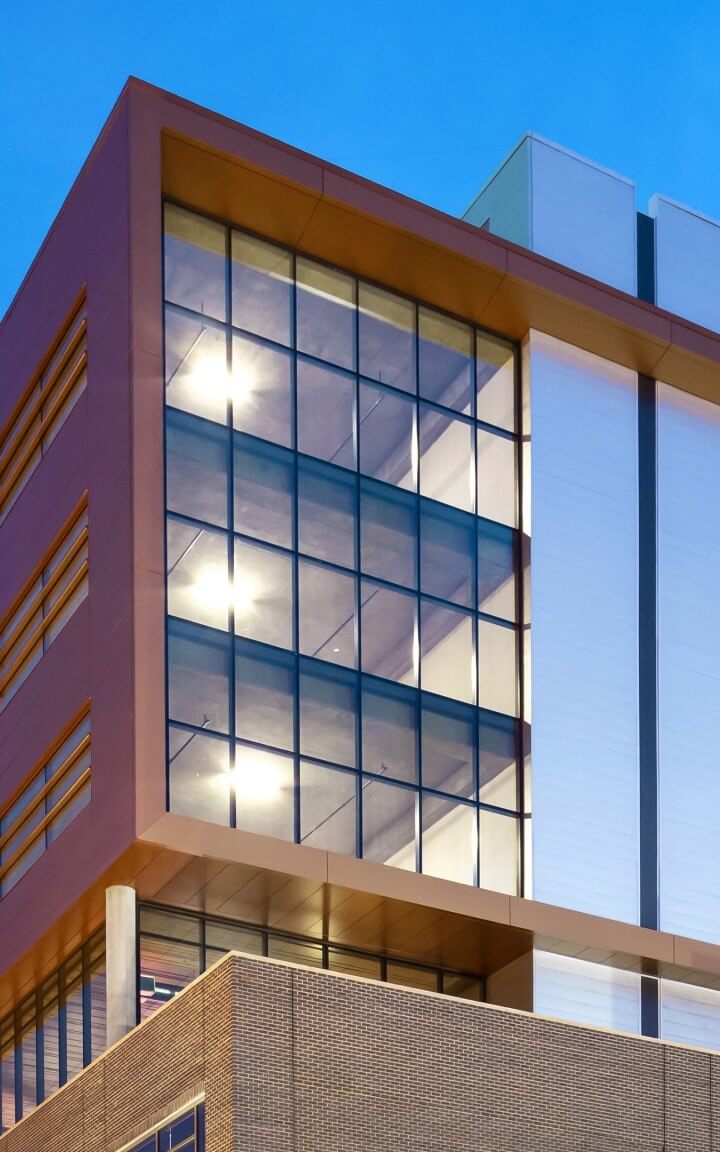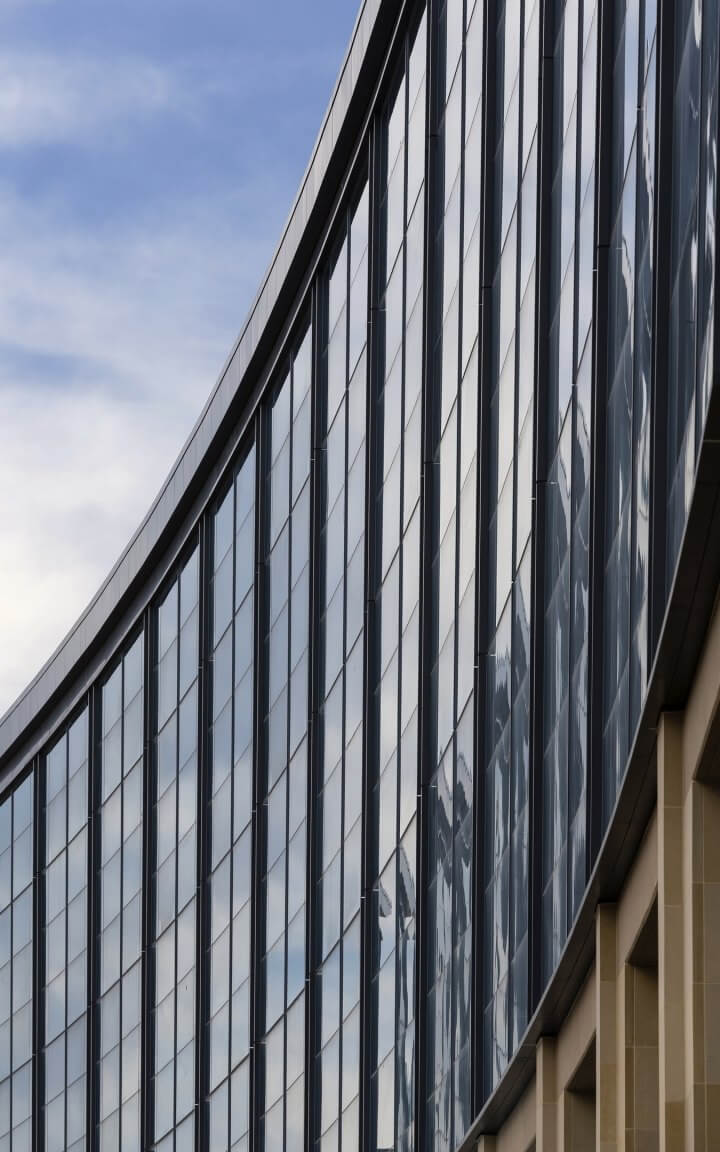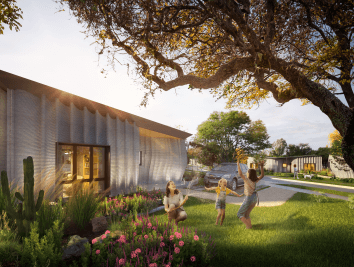Making Sustainability Affordable
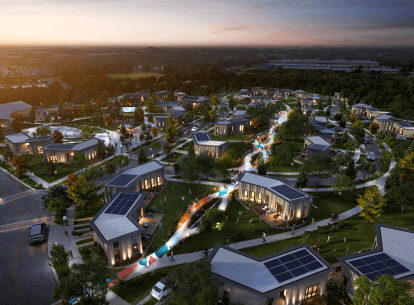
To address the issue of stable and affordable housing for low-income households, Icon, an Austin-based pioneer in 3D-printed homes, created the Initiative 99 challenge. Corgan participated in the challenge. After interviews with single parents, Corgan learned of the anxiety that bills cause. Therefore, their primary focus was to design an affordable, sustainable 3D printed home that would alleviate the stress – emotional and financial – that utility bills can cause. The team took a hard look at every element to make the project as sustainable and efficient as possible. By using a new construction typology, the idea of sustainability stretched to include not just green practices, but ones that make a home stable and livable:
I don’t want to have to choose between paying my energy bill and buying groceries for my family.
To help minimize utility costs and safeguard the stability of the parents’ situations, we looked for every way we could make our design more efficient, with a focus on natural ventilation, heat reduction, water conservation, and solar energy generation. In addition to being more cost effective and ensuring the long-term viability of the home, the design is also energy efficient: the printed home will be carbon negative after a decade, meaning it removes more carbon dioxide from the atmosphere than it emits. Sustainability efforts are often seen as more expensive, but by using the 3D concrete printing technology, we were able to make sustainability affordable.
Making the most of the situation
The path toward maximizing the efficiency of the house began with a site analysis: Austin is in zone 2A and is classified as a hot-humid climate meaning there is a considerable level of heat stress, especially in the summer. Our focus was on minimizing heat gain through façade shape, vegetation, and other elements. Reducing the solar radiation to prevent overheating while using natural daylight was one the main concerns for the building orientation—it was important to critically evaluate the west exposure as it substantially contributes to the peak cooling load. Data also revealed the frequency and strength of winds throughout the year, so achieving natural ventilation was yet another focus in the schematic design phase. We were able to reduce the mechanical cooling costs by combining cross ventilation and ceiling fans. In humid places such as Austin, air ventilation and movement play a crucial role in preventing air stagnation and growth of mold in the space.
The team also designed a solar deflection façade with optimized fins to reduce solar gain. The 3D-printing technology makes the walls easily configurable, so the fins can be angled to deflect the most sun, regardless of the site orientation, therefore reducing the amount of heat brought into the house and the amount of cooling needed. In total, the solar insolation results in a 32 percent decrease in solar heat gain. Maximizing daylight and employing natural ventilation techniques were also key to reducing energy costs. Using the right orientation and optimizing the fin orientation to minimize solar exposure using Dynamo, the design reached the Spatial Daylight Autonomy (sDA) of 84 percent with only six percent of Annual Sunlight Exposure (ASE) throughout the whole year, meaning the least amount of glare while maximizing the benefits of daylight.
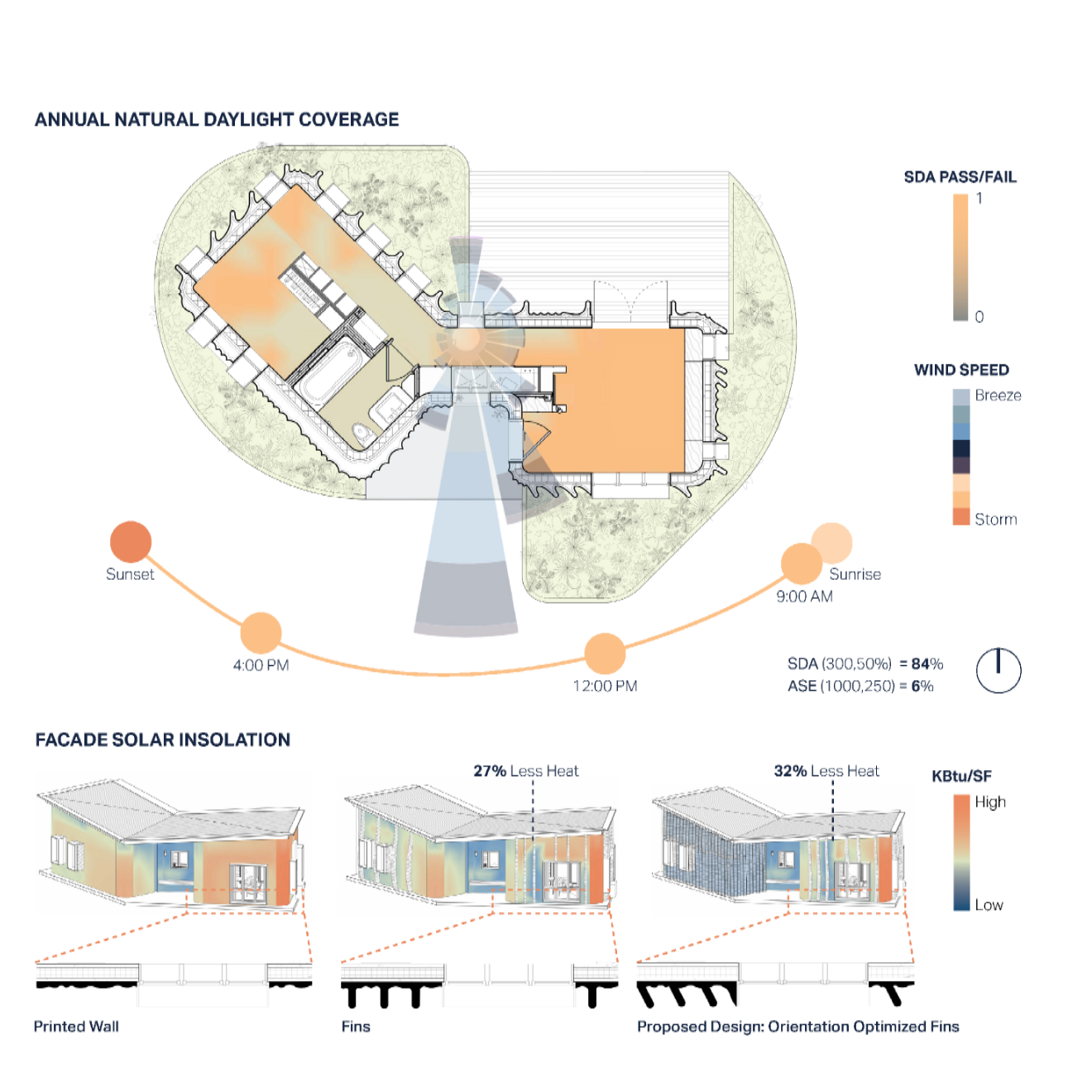
Here comes the sun
The team also looked at ways to take advantage of the site’s climate and 3D printing technology to create a net positive building. To benefit from the region’s rainfall, a 600-gallon sloped water tank was embedded within the 3D-printed façade that captures rainwater and feeds into restroom plumbing fixtures, saving up to 5,672 gallons of water annually. The water wall serves the dual purposes of insulation and rainwater collection. The design also includes a photovoltaic system that – in the Austin sun – generates 9,096 KWh per year, enough to offset all the electricity usage of the building and store a considerable amount of residual energy using the lithium battery connected to the system. To put those numbers in perspective, the code minimum for energy usage per square foot is 32 KBtu. The efficiency of the design without the photovoltaic panels is already down to 11 KBtu per square foot; with the solar panels the energy use drops to negative 8 KBtu per square foot.
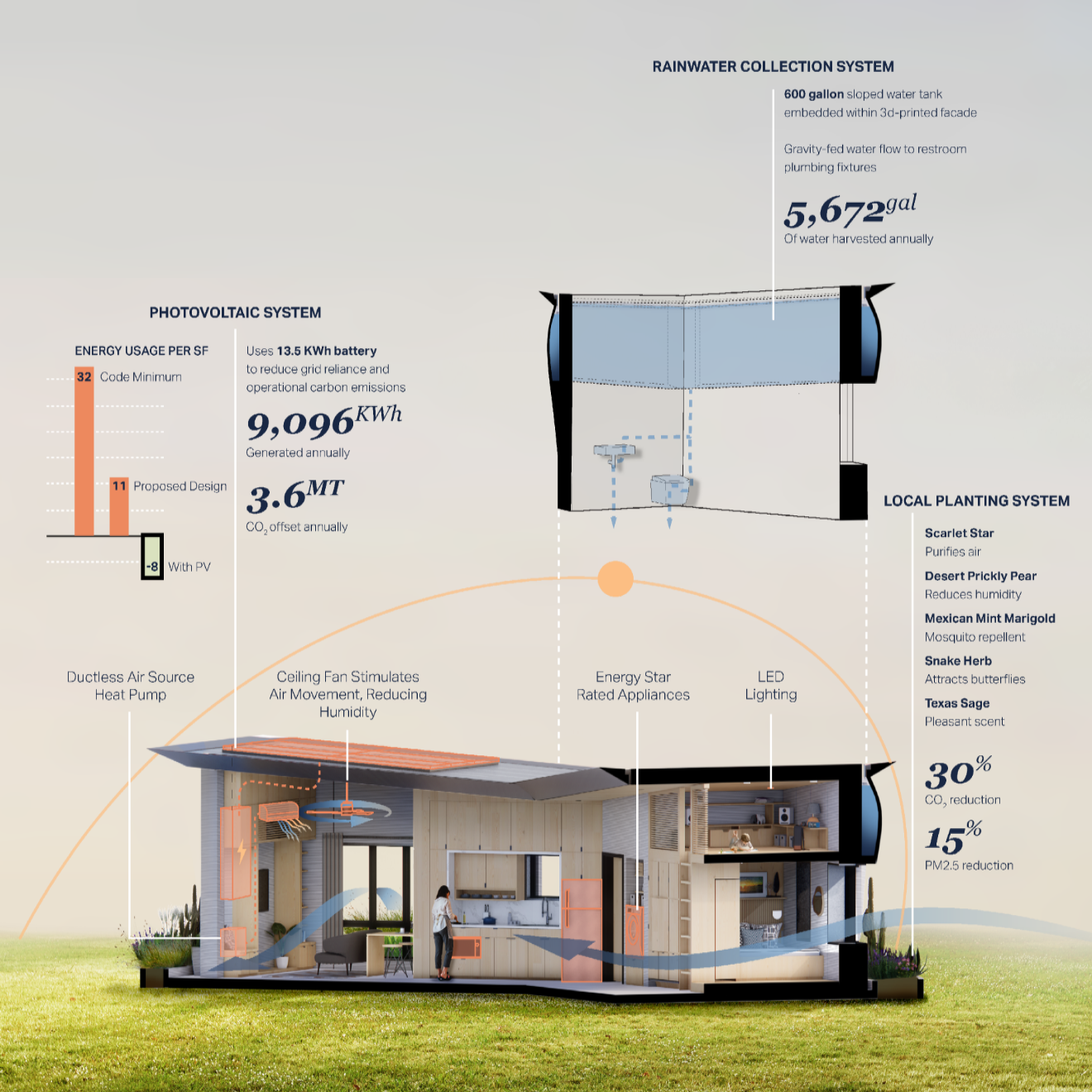
The house's reliance on energy-efficient appliances and use of a ductless air source heat pump for water heating and air conditioning further contributed to its sustainability. Other sustainable fixtures include a ceiling fan, Energy Star rated appliances, and LED lighting. Overall, energy expenses are reduced from $828 per month to $216 per month for water, electric, and heat.
The finishing details
The sustainability of the design extends to the construction process and material selection. By leveraging modular prefabricated construction techniques, we enabled a smooth and weather-independent construction process that also provides a high level of customization – the interior was planned for a single mother with children but can easily be adapted to work for a nuclear family, a single person, or roommates – without changing the 3D-printed exterior. The interior assembly process is assembled off-site using locally sourced yellow pine, a LEED qualification. Overall, the prefab construction of the interior modules means the houses can be built twice as fast, with 90 percent less waste, and 20 percent less cost than traditional construction methods.
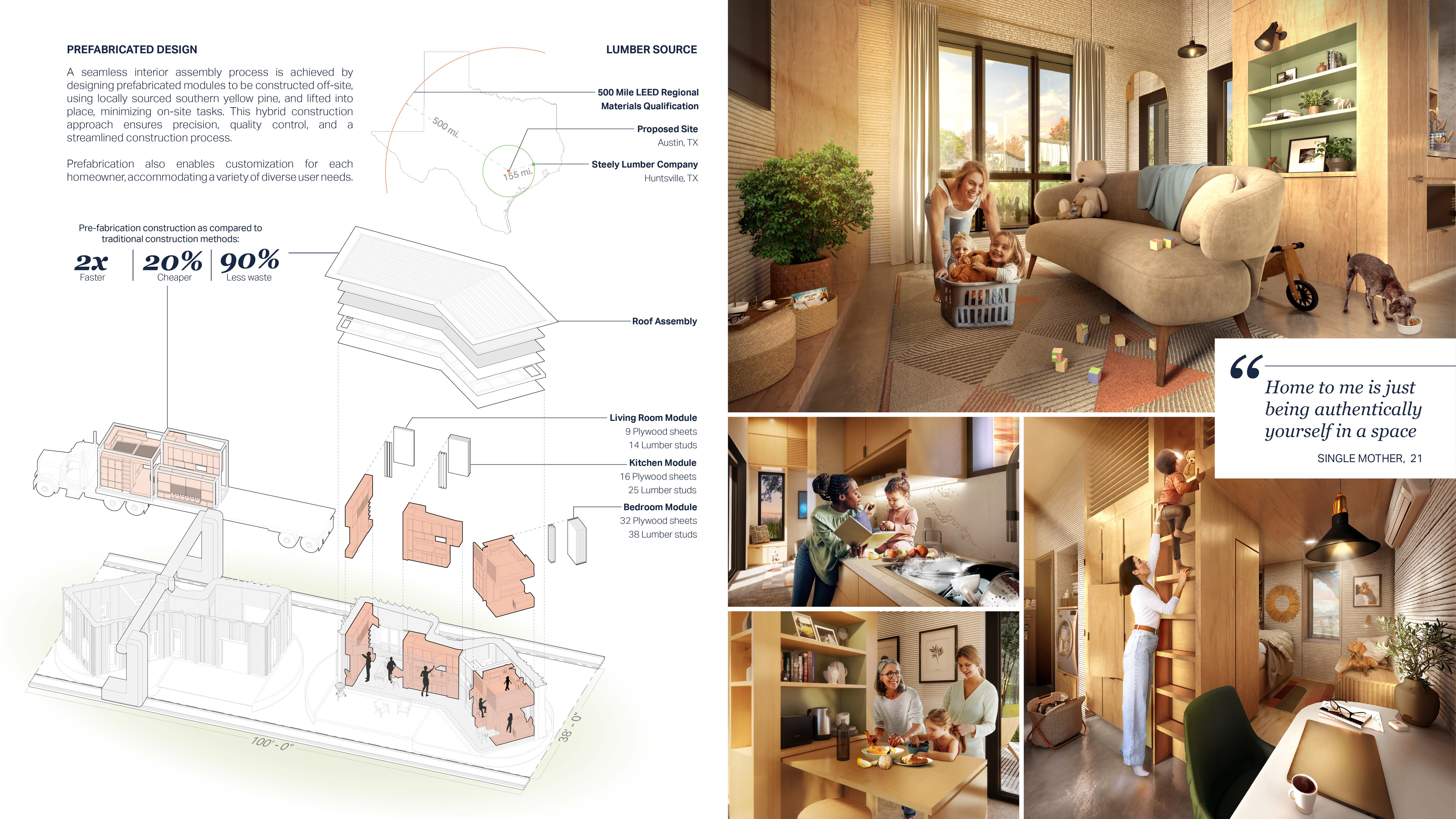
Our team left no stone unturned in their effort to reduce costs, make the house more comfortable, and increase the design’s sustainability. After exhausting every facet of the shell and interior, they turned to the outside landscaping. Plants were carefully selected for their environmental benefits and include scarlet star, desert prickly bear, Mexican mint marigold, snake herb, and Texas sage. These native plants can purify the air, reduce humidity, repel mosquitos, and attract butterflies—and use very little water. Overall, the small garden in front of each house reduces carbon dioxide by 30 percent and air pollution (PM2.5) by 15 percent. By strategically placing a functional plant box in front of the operable windows, we were able to filter the air coming in and thus increase the air quality and wellness of our occupants.
At the community scale, we implemented bioswales in our landscaping strategy to effectively manage stormwater runoff, filter pollution, and enhance groundwater recharge. By thoughtfully incorporating native xeriscaping, we not only conserve water but also create habitats conducive to wildlife such as bees and hummingbirds. This design choice simultaneously minimizes water consumption for landscaping purposes. Moreover, by adopting air source heat pumps for our buildings' mechanical systems and integrating light-colored pavements and facades, we significantly mitigated the heat island effect within our community. Establishing a community garden serves as a vital carbon sink, absorbing atmospheric carbon dioxide through photosynthesis while nurturing plant growth. As residents tend to the garden, they contribute to the sequestration of carbon, helping to offset carbon emissions in the local environment. By fostering biodiversity and enriching the soil, the gardens further enhance their capacity as carbon sinks, playing a crucial role in mitigating climate change on a community level.
Double benefit
Environmentally friendly, sustainable features are often seen as expensive extras, but they don’t have to be. Likewise, efficient, affordable housing doesn’t have to be impersonal, cramped, or ugly. With the nation facing a housing crisis and the world facing a climate crisis, designing sustainable, affordable housing offered us an opportunity to contribute solutions to two problems at once.
